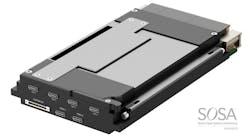Embedded computing products aligned to SOSA and other open-systems standards introduced by General Micro
RANCHO CUCAMONGA, Calif. – General Micro Systems in Rancho Cucamonga, Calif., is introducing the X9 Venom family of 3U and 6U OpenVPX computer boards, peripherals, and ATR-style chassis for use in military ground, air, communications, and weapons applications.
The X9 Venom family of 21 embedded computing products, available by early 2023, starts with the 3U and 6U single-board computers based on Intel and NVIDIA processors and general-purpose graphics processing units (GPGPUs).
All products follow ANSI/VITA 65 standards, meet the U.S. Department of Defense (DOD) requirement for Modular Open Standards Approach (MOSA) electronic systems, and are IEEE 1101.2 conduction cooled.
X9 Venom products align to the Sensor Open Standard Architecture (SOSA) and other open-systems standards, and are ready to meet C4ISR/Electronic Warfare Modular Open Suite of Standards (CMOSS).
Related: SOSA and open standards for military embedded computing
The GMS X9 Venom product line relies on a modular and super-dense X9 architecture and I/O, through-board and external connectors, signal conditioning, power management, and cooling to increase the functionality of each X9 Venom single board computer -- better called a single-board system.
GMS folds a computer board with many functions into several 3U-sized boards that fit into either one or two 3U slots. 16-gigabit-per-second PCI Express 4 signals connect the stacked boards. 100-gigabit fiber optic data and Thunderbolt 4 signals to the front panel.
GMS 3U and 6U ATR-PLUS chassis are designed to handle backplane and front=panel copper and fiber data. The 6U-sized X9 Venom boards are all single slot but essentially take the three-board X9 architecture and place it onto one 6U board.
All boards or chassis use clamshell heat sinks, wedgelocks, RuggedCool, or Diamond RuggedCool hot-spot cooling and stiffeners, and can use LightBolt front-panel connectors for copper, fiber, or fiber with as much of 100 Watts of power delivery.
The GMS X9 architecture is Thunderbolt 4 technology. This Intel/Apple 40-gigabit-per-second interface provides USB 4/3/2, DisplayPort, PCI Express, 10-gigabit-per-second Ethernet, and as much as 100 Watts of power. With Venom single-board systems, Thunderbolt 4 ports and 100-gigabit Ethernet allow data movement between cards and outside of the ATR box.
Available in single-slot or dual-slot versions, in 3U or 6U sizes, and in air- or conduction-cooled versions, X9 Venom single-board computers are available with Intel's 8 core Xeon W (Tiger Lake H), Intel's 20 core Xeon D-2700 (formerly Ice Lake D HCC), or NVIDIA's Jetson AGX Orin GPGPU machine image vision/AI processor.
Each single-board computer also can be available with network-oriented functions, network-attached storage functions, or artificial intelligence functions. Options include as much as 48 terabytes of on-board storage, four to six 100-gigabit Ethernet ports, supplemental NVIDIA RTX5000 GPGPU co-processor, and as many as six Thunderbolt 4 40-gigabit ports.
Processors either are Intel Xeon W Core i7 or Intel Xeon D Ice Lake as single-board system, or as network-centric with two to six RDMA 100-Gigabit Ethernet and two to four Thunderbolt 4 ports, or as network-attached storage with as much as 48 terabytes VROC RAID storage, and two to four Thunderbolt 4 ports plus two to four 100-Gigabit Ethernet ports with Intel iWRAP and RoCEv2 on Ice Lake D systems. All processor modules have several low-speed I/O plus legacy I/O options, along with optional NVIDIA GPGPU.
CPUs either are Intel Xeon W Core i7 or Intel Xeon D Ice Lake, or as network-centric with four to six RDMA 100-Gigabit Ethernet and two to four Thunderbolt 4 ports, or as network-attached storage with as much as 48 terabytes VROC RAID storage, and two to four Thunderbolt 4 ports plus two to four 100-Gigabit Ethernet ports with Intel iWRAP and RoCEv2 on Xeon D systems. All processor modules have several low-speed I/O plus legacy I/O options, along with optional NVIDIA GPGPU.
Additional OpenVPX Venom modules include NVIDIA Jetson AGX Orin GPGPU for artificial intelligence with image processing frame grabber inputs; 20-port Ethernet switch ; and 1000-Watt redundant N+1 SOSA-aligned smart VPX power supply.
GMS ATR-PLUS and ATR-MAX chassis come in aluminum alloy or in carbon fiber to save as much as 30 percent in weight. Per-slot heat pipe cooling improves reliability and extends operating range. All chassis front panels include high- and low-speed copper connectors plus fiber connectors for internal backplane and card front panel wiring.
3U chassis have six or eight slots, a removable 4-SSD canister for data storage, and two slots for dual 1000-Watt smart power supplies. 6U chassis include two canisters for removable storage and eight slots, with two reserved for power supplies. All Thunderbolt technology-equipped chassis offer 100-Watt power delivery over fiber.
For more information contact General Micro Systems online at https://gms4sbc.com/x9venom.
